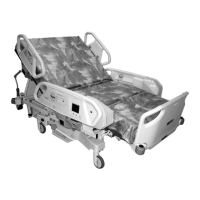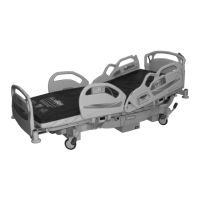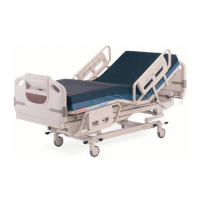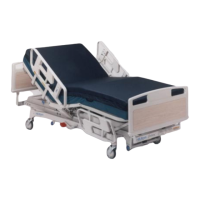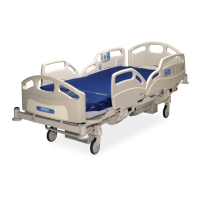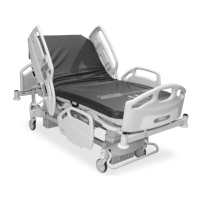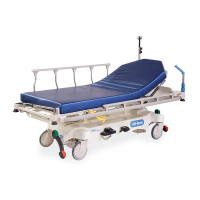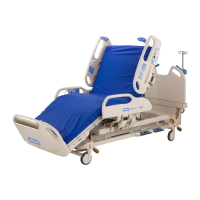Do you have a question about the Hill-Rom P1840 and is the answer not in the manual?
Explains warning and caution symbols and their implications for safety and equipment.
Details the purpose and suitable environments for the TotalCare Bariatric Bed.
Lists and illustrates key components of the bed system with item labels.
Overview of the FullChair Patient Position Mechanism for chair positions.
Explains the chair egress feature and patient positioning for exit.
Explains the HandsFree Trendelenburg mechanism, activation, and transport.
Provides warnings on siderails as restraints and patient entanglement.
Discusses restraint facilitation, recommendations, and warnings.
Details activation and deactivation procedures for the Bed Exit Alarm.
Explains the Head Angle Alarm's purpose, activation, and clearing.
Details activation, deactivation, audible alarm, and delay settings.
Provides warnings on bed exit system use and visitor weight impact.
Details the surface therapy, weight range, and provides warnings.
Warns about sleep surface impermeability being affected by needle sticks.
Describes P/V therapies, warnings, and installation.
Explains Alarm Pause function, warnings, cautions, and silencing.
Warns about sleep surface impermeability being affected by needle sticks.
Details patient weight limits and Safe Working Load (SWL) for bed models.
Provides warnings on ankle restraints and patient entanglement risks.
Details the chair feature, its activation, and patient support.
Offers warnings on transport, patient sitting, ankle restraints, and sheets.
Provides warnings on transport, ankle restraints, and foot support.
Emphasizes the importance of always setting the brakes.
Warns about angle, low position, and AC power loss effects on Trendelenburg.
Covers scale purpose, controls, zeroing, weighing, and item adjustments.
Offers warnings on bed exit system usage and visitor weight impact.
Details the activation and deactivation procedures for the Bed Exit Alarm.
Details Rotational Therapy, its reminders, and activation.
Explains CPR function activation and stopping Max-Inflate.
Details the surface therapy, weight range, and provides warnings.
Warns about correct patient alignment for P/V therapies.
Provides critical warnings regarding exceeding patient characteristics and SWL.
Provides warnings on patient positioning, seat belt, and foot support in chair mode.
Details the CPR release function, activation, and stopping Max-Inflate.
Warns about applying outward force on siderails and potential instability.
Warns about observing lines closely during rotations to prevent injury.
Explains CPR function activation and stopping Max-Inflate.
Provides instructions for installing and removing Rotation/Percussion/Vibration modules.
Provides detailed measurements and specifications for bed positions.
Provides warnings and installation instructions for the Patient Helper.
Offers warnings on arm installation, use, lines, and sensitive devices.
Warns about bed positioning when the patient is unattended.
Warns about siderail entanglement risks, especially with agitated patients.
Warns about deactivating bed functions with lockout control.
Warns about overbalance, tipping, and speed during transport.
Warns about bed articulations and line management.
Warnings for patient helper assembly, use, headboard, and SWL.
Emphasizes the importance of setting brakes for patient safety.
Warns about patient entrapment risks and unattended bed positioning.
Warns about power cord handling, earth conductor integrity, and EMC.
Warns about accessory placement affecting stability.
Covers setting brakes and line management during chair positioning.
Provides instructions and warnings for handling fluid spills on the bed.
Provides warnings on using siderails, side extenders, and the foot section.
Provides transport cautions, warnings, and accessory guidelines.
Warns about patient restraints, their use, and monitoring.
Covers precautions for flammable gases and oxygen tents.
Warns that only authorized personnel should troubleshoot the system.
Explains warning and caution symbols and their implications for safety and equipment.
Details the purpose and suitable environments for the TotalCare Bariatric Bed.
Lists and illustrates key components of the bed system with item labels.
Overview of the FullChair Patient Position Mechanism for chair positions.
Explains the chair egress feature and patient positioning for exit.
Explains the HandsFree Trendelenburg mechanism, activation, and transport.
Provides warnings on siderails as restraints and patient entanglement.
Discusses restraint facilitation, recommendations, and warnings.
Details activation and deactivation procedures for the Bed Exit Alarm.
Explains the Head Angle Alarm's purpose, activation, and clearing.
Details activation, deactivation, audible alarm, and delay settings.
Provides warnings on bed exit system use and visitor weight impact.
Details the surface therapy, weight range, and provides warnings.
Warns about sleep surface impermeability being affected by needle sticks.
Describes P/V therapies, warnings, and installation.
Explains Alarm Pause function, warnings, cautions, and silencing.
Warns about sleep surface impermeability being affected by needle sticks.
Details patient weight limits and Safe Working Load (SWL) for bed models.
Provides warnings on ankle restraints and patient entanglement risks.
Details the chair feature, its activation, and patient support.
Offers warnings on transport, patient sitting, ankle restraints, and sheets.
Provides warnings on transport, ankle restraints, and foot support.
Emphasizes the importance of always setting the brakes.
Warns about angle, low position, and AC power loss effects on Trendelenburg.
Covers scale purpose, controls, zeroing, weighing, and item adjustments.
Offers warnings on bed exit system usage and visitor weight impact.
Details the activation and deactivation procedures for the Bed Exit Alarm.
Details Rotational Therapy, its reminders, and activation.
Explains CPR function activation and stopping Max-Inflate.
Details the surface therapy, weight range, and provides warnings.
Warns about correct patient alignment for P/V therapies.
Provides critical warnings regarding exceeding patient characteristics and SWL.
Provides warnings on patient positioning, seat belt, and foot support in chair mode.
Details the CPR release function, activation, and stopping Max-Inflate.
Warns about applying outward force on siderails and potential instability.
Warns about observing lines closely during rotations to prevent injury.
Explains CPR function activation and stopping Max-Inflate.
Provides instructions for installing and removing Rotation/Percussion/Vibration modules.
Provides detailed measurements and specifications for bed positions.
Provides warnings and installation instructions for the Patient Helper.
Offers warnings on arm installation, use, lines, and sensitive devices.
Warns about bed positioning when the patient is unattended.
Warns about siderail entanglement risks, especially with agitated patients.
Warns about deactivating bed functions with lockout control.
Warns about overbalance, tipping, and speed during transport.
Warns about bed articulations and line management.
Warnings for patient helper assembly, use, headboard, and SWL.
Emphasizes the importance of setting brakes for patient safety.
Warns about patient entrapment risks and unattended bed positioning.
Warns about power cord handling, earth conductor integrity, and EMC.
Warns about accessory placement affecting stability.
Covers setting brakes and line management during chair positioning.
Provides instructions and warnings for handling fluid spills on the bed.
Provides warnings on using siderails, side extenders, and the foot section.
Provides transport cautions, warnings, and accessory guidelines.
Warns about patient restraints, their use, and monitoring.
Covers precautions for flammable gases and oxygen tents.
Warns that only authorized personnel should troubleshoot the system.
| Brand | Hill-Rom |
|---|---|
| Model | P1840 |
| Category | Medical Equipment |
| Language | English |

